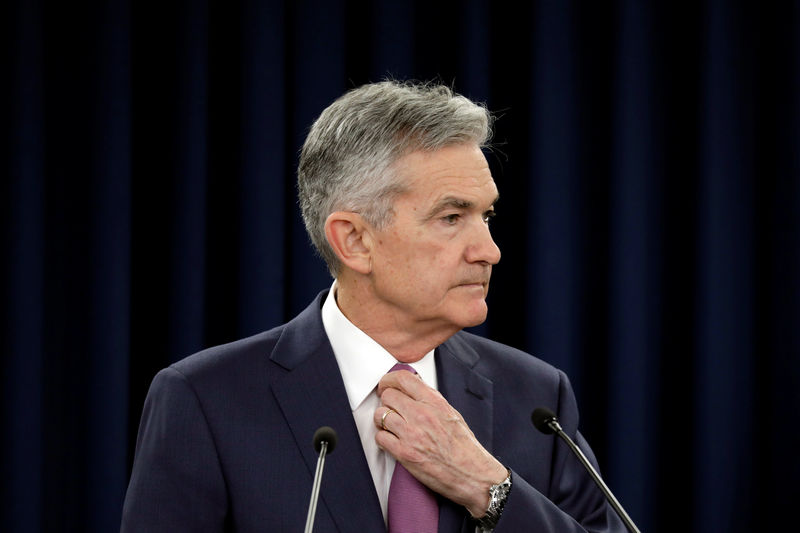 © Reuters. Fed Indicates Bond Traders Are Behaving for Now
© Reuters. Fed Indicates Bond Traders Are Behaving for Now(Bloomberg Opinion) — Federal Reserve Chair Jerome Powell gave traders in the world’s biggest bond market the equivalent of a pat on the head after the central bank’s latest meeting.
The Federal Open Market Committee voted unanimously to leave the fed funds rate in a range of 0% to 0.25%, as expected, with all but two officials forecasting it will remain near zero until at least 2023. Notably, the Fed’s statement made no formal mention of yield-curve control, the policy tool seemingly on the tip of all analysts’ tongues. More than half of economists surveyed by Bloomberg said they anticipate the FOMC will eventually set target yields for certain Treasuries, likely two- or five-year maturities. Of those expecting that to happen, most said the announcement would most likely come in September.
Powell didn’t box the Fed into committing to the policy. The usefulness of yield-curve control in the U.S. “remains an open question,” he said in his opening statement. “We will continue our discussions in upcoming meetings and will evaluate our monetary policy stance and communications as more information about the trajectory of the economy becomes available.” When the first question from a reporter pressed him about how soon it could happen, he repeated his language from the statement verbatim.
As for bond purchases, officials surprised some traders by announcing that they’re extending the program in the coming months “at least at the current pace,” which amounts to about $80 billion of U.S. Treasuries and $40 billion of agency mortgage-backed securities a month. (For reference, during the worst of the market tumult in March, the Fed was buying $75 billion of Treasuries each day.) The Fed’s balance sheet stands at $7.17 trillion, up from $4.16 trillion at the end of February.
The Fed has been paring back its buying gradually week by week, so locking in at current levels suggests Powell and his colleagues don’t want to risk any sort of trouble with market plumbing as the Treasury Department ramps up bond sales to fund gaping budget deficits. “We will closely monitor developments and are prepared to adjust our plans as appropriate to support our goals,” Powell said. In other words: The Fed stands ready to buy more Treasuries if private investors suffer from indigestion.
That kind of “floor” was dovish enough to send Treasury yields tumbling across the curve in the wake of the decision. The benchmark 10-year yield dropped as much as 10 basis points, the most since April 15, while five-year yields fell 7 basis points. Yield curves broadly flattened on the perceived support from Fed purchases.
I wrote after the previous FOMC meeting in April that judging by Powell’s comments, the central bank will keep policy accommodative long after the coronavirus pandemic subsides. Wednesday’s decision and his latest remarks merely add more specifics. Moreover, Labor Department data released a few hours beforehand showed the core consumer price index fell for the third consecutive month, the first time that has happened in data going back to 1957. The central bank will be in no hurry to raise interest rates with such a grim outlook for price growth.
Of course, risk-asset prices have been soaring. Powell sought to frame that in the Fed’s preferred terms. “There have been gains in market function, although not fully back to where you would say they were for example in February, before the pandemic arrived. We don’t take those gains for granted,” he said. Powell caught himself as he said the central bank’s bond buying is supporting “highly accommodative — or, accommodative — financial conditions.”
As long as Treasuries stay in their current ranges and credit spreads remain steady enough that investment-grade companies can borrow at some of the lowest costs in history, there’s no incentive for the Fed to change course. Powell made clear, especially in an impassioned answer to Bloomberg TV’s Michael McKee to end the press conference, that stocks can go as high as investors want — he and his colleagues will be focused on setting policy and establishing facilities that cut into the 13.3% U.S. unemployment rate and keep markets wide open.
Keep it up, bond traders. Powell will check back in at the end of July.
This column does not necessarily reflect the opinion of the editorial board or Bloomberg LP and its owners.
Brian Chappatta is a Bloomberg Opinion columnist covering debt markets. He previously covered bonds for Bloomberg News. He is also a CFA charterholder.
©2020 Bloomberg L.P.
Fusion Media or anyone involved with Fusion Media will not accept any liability for loss or damage as a result of reliance on the information including data, quotes, charts and buy/sell signals contained within this website. Please be fully informed regarding the risks and costs associated with trading the financial markets, it is one of the riskiest investment forms possible.




0 Comments:
Post a Comment